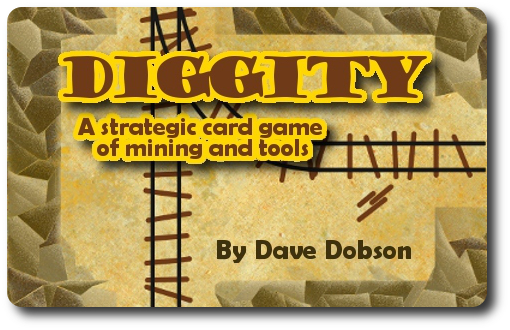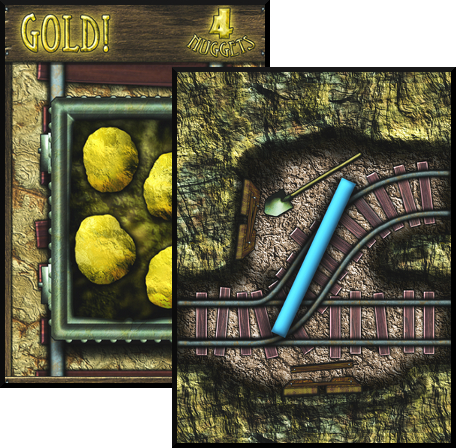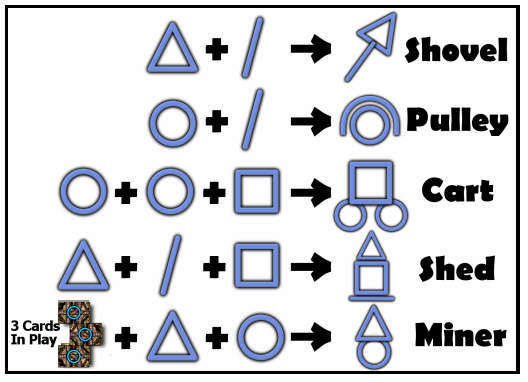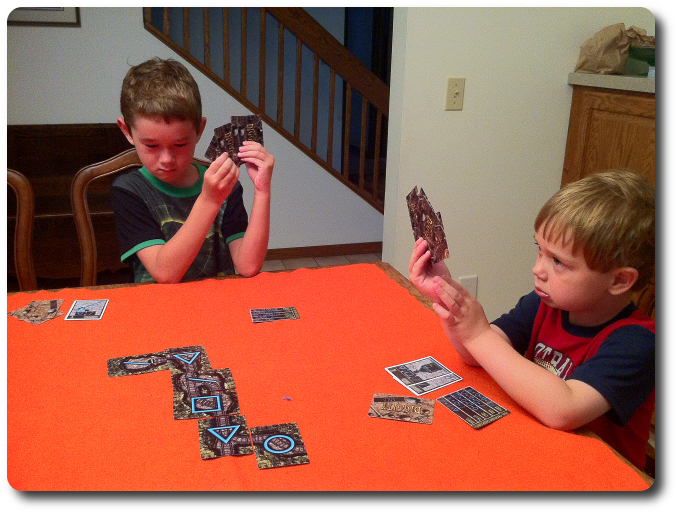
The Basics:
- For ages 5 and up (designer suggests 12+)
- For 2 to 4 players
- Variable game length
Geek Skills:
- Counting & Math
- Logical & Critical Decision Making
- Reading & Writing
- Pattern/Color Matching
- Strategy & Tactics
- Visuospatial Skills
- Hand/Resource Management
Learning Curve:
- Child – Easy
- Adult – Easy
Theme & Narrative:
- There’s gold to be won, but you aren’t the only miner who is looking for it!
Endorsements:
- Gamer Geek approved!
- Parent Geek approved!
- Child Geek approved!
Overview
There’s gold in those hills! You can feel it in your bones and taste it in the air! But you have to dig for it and that is going to take work, skill, and luck. But you can’t do it alone, either. Other miners will want in on this opportunity, but the gold will go to the miner who has the best tools to extract it, not the miner who finds it. Keep a sharp eye out for the glint of riches and keep your shovel at the ready! Time to go get rich!
Diggity, by Plankton Games, is comprised of 64 Mine cards, 16 Tool cards (4 sets with 4 tool types per player), 16 Gold cards, and 4 Tool Information cards (player reference cards). The component quality is excellent and the artwork is superb.

Example of a Gold and Mine card
Game Set Up
To set up the game, first separate the cards into three different decks. There will be one Mine, one Gold, and one Tool deck. This is very easy to do as each deck will have not only have a different colored card backing, but is also clearly labeled.
Second, from the Tool deck, grab 1 tool set for each player. A complete set is comprised of a shovel, pulley, cart, and shed Tool card type. Create a deck for each Tool type and place them face-up off to the side of the playing area. For example, if you are playing a 3-player game, you will have 3 Tools of each type in the 4 different Tool decks (3 shovels, 3 pulleys, 3 carts, and 3 sheds). Any unused Tool cards are removed for the duration of the game.
Third, shuffle the Mine deck and deal each player Mine cards. The number of cards dealt to each player is determined by the number of participants. These cards are dealt face-down and the players should keep them hidden from their opponents at all times. The remaining cards in the Mine deck are placed to one side of the playing area.
Fourth, shuffle the Gold deck. When setting up the game, you can reduce the time needed to play by removing Gold cards. The rules suggest removing half of the Gold cards for a 3 or 4-player game, but you can remove any number without breakingDiggity. Less Gold means shorter play time and fewer points to win. The option of making the game scoring more flat is also available at game set up time by removing the Gold cards worth 5 and 6 points. All this does is remove the chance that a player could jump ahead with a great deal of points with a single Gold card. Again, removing the cards is optional and it does not break the game play of Diggity. Once the number of Gold cards is determined and shuffled, place the Gold deck next to the Mine deck.
Last, give each player 1 Tool Information card. These are placed in front of the owning player for quick reference.
Determine who is the first player and get digging!
Digging Tunnels
A player’s turn has 3 steps that are taken in sequential order. These steps are as follows:
Step 1: Play a Card
The player selects one of their cards from their hand and plays it to the mine. If there are no Mine cards in play (meaning this is a new mine), the player is welcome to play any card from their hand. Otherwise, a player must play a card using the following rules:
- When playing a card, at least one mine track must connect to an open mine track of the card already in play
- When playing a card, it cannot overlap or cover any part of another card in play – touching another card’s edge is legal
Players can rotate their Mine card anyway they choose as long as it follows the two important rules of playing a card. It is also perfectly permissible to have a mine track terminate into another card that does not connect to another mine track as long as at least one track on the new card connects to an open mine track in play. An easy way to remember this is to pretend you are walking through the mine. You should be able to get to any part of the mine from any point by simply following the mine tracks.
If the player does not have a card they can play legally using the rules, their turn is automatically over and the next player goes.
Step 2: Evaluate Mine
The player now evaluates the mine using the card they just placed. This is a very important step as it allows the player to collect tools and discover gold. Tools are collected by creating combinations with shapes found on the Mine cards. Each Mine card will have one symbol. Using these symbols, a player determines if any tools are available to collect. The tools and the combination symbols needed are shown in the following image.

Tool combos (Tool Information cards supply this information)
The rules for determining what tools are available are as follows:
- The symbols must be connected directly to the cards to the be used via a mine track (for example, the pulley tool must have the Mine cards with the circle and the line symbols directly connect without another Mine card in between them)
- Mine cards used for the tool can be connected in any order (for example, you do not have to have played the circle first to get the pulley tool)
- Mine card orientation is not important (symbol orientation is not a requirement)
- A player can only take one tool, regardless of how many they create
If a tool is created, the player takes the matching tool from the Tool decks and places it in front of them, face-down. If there are no tools of that type in the deck, the player can steal the tool from an opponent. All players must reveal at least one of the Tools to the player if they have one, but not all. For example, if a player just created a shovel tool, but there were none left to take from the deck, all the other players who have a shovel would show only 1 shovel Tool card, regardless of how many they might have.
If instead of a tool the player is able to create a miner (with at least 3 Mine cards already in play – meaning the card that is played would be the fourth card), they can draw and reveal the top Gold card. Now players use their Tool cards to get the gold.
To play a Tool card, a player simply selects one of their tools and plays it in front of them, face-up. The player who discovered the gold goes first. Each Tool card has a tool value which determines the “strength” of the tool, starting with “1” (the shovel) and ending with “4” (the shed). The first Tool card that must be played is the shovel which is a “1”. The next card is the pulley which is a “2”. Tool cards must be played sequentially. The player who plays the highest value Tool card (which would be a “4”) wins the Gold card. All played Tool cards are collected and set to one side of the playing area in the same position they started when the game was set up. If a player cannot play a Tool card in sequential order or chooses not to, they are out of the bidding for the Gold. This includes the player who finds the gold.
Successfully claimed Gold cards are placed in front of the player.
Step 3: Draw a Card
The very last step of a players turn, regardless if a tool was claimed, spent, or gold won, is to draw 1 Mine card. If there are no more Mine cards, shuffle the discarded Mine cards to create a new Mine deck.
This completes the player’s turn. The next player in clockwise order now takes their turn starting with Step 1.
Closing a Mine
Players will continue to build on the mine until one of two conditions are met.
- No player can add a Mine card to the mine (no legal placements left)
- Gold is found and collected
As soon as either of two conditions are met, all the Mine cards are picked up and placed in a discard pile. Tools and any gold can still be collected before the mine is closed by the player who placed the last Mine card. The next player starts a new mine by playing any of their Mine cards.
Ending the Game
The game ends after the last Gold card has been claimed by a player. All the players now count up the number of nuggets on each of their Gold cards. The player with the most gold nuggets win the game!
Game Variants
Instead of each player placing their collected Tool cards face-down, have each player keeps them face-up.
To learn more about Diggity and read the full rules, see the game’s web site.
Prediction
Games where exploration is part of the game play are always a hit with my little geeks. Add in the element of puzzle solving, as needed to determine where and when to play Mine cards, and this game is sure to be a winner. The simple game play will allow for my 5-year-old to participate, but to play the game well will take a bit of skill. First of all, there is a lot of hand management needed. How so? Consider for a moment that part of the mine building exercise is to create specific combinations to acquire tools and gold. The timing and placement of your cards will impact not only your level of success in the game, but also your opponents. Timing becomes a factor and balancing a bit of risk versus reward when determining when to play a card. Do I play it now and work on getting a tool, or if I play this card now will I be creating a good combo for my opponents? For a 5-year-old, this is going to be a thinker.
Second, there is also the use of tools to acquire the Gold card once it is displayed via the creation of a miner. Tools suddenly become bargaining chips, but the price you are paying for that gold might be a bit high. For example, if a 1 nugget Gold card comes into play, do I want to spend all my Tool cards to get it? What is the current tool strength of my opponents and is it worth me spending so much to get a Gold card early in the game? Yikes! When you start to break down this game, it is clear Diggity can be a pretty intense thinking exercise.
I love it!
Teaching the game to our test groups didn’t take long. The Gamer Geeks and Parent Geeks easily understood the goal and how to collect cards, with the Gamer Geeks being particularly impressed with how players need to build combos in the mine. The Child Geeks took longer as they were uncertain how to build the more complex combinations and why they should wait to spend their cards. I took my time here and made sure my little geeks understood the need to play cards intelligently and to take advantage of opportunities. By and large, I think my 5-year-old is unable to grasp the “big picture”, but my 7-year-old understood it perfectly.
After a few more demonstrations and answering some pretty thoughtful questions, I asked my little geeks what they thought of the game so far while I reset the game for our first play.
“I like how the Mine cards look and fit together. It is neat to build the mine as a group.” ~ Liam (age 7)
“I like how we solve it like a puzzle.” ~ Nyhus (age 5)
Let’s get digging with Diggity and see if our efforts are worthwhile or if we are just digging ourselves into a hole.
Final Word
For our first game, we played with all our cards showing. This turned out to be exactly what was needed as my little geeks started to suffer analysis paralysis early on in the game. Not because the choices were hard, mind you, but because they became overwhelmed with all the possibilities. The level of strategy needed to play the game competitively is surprisingly high as the player must carefully consider their timing, their opponents’ strength, and their current score. My 7-year-old understood this and became too concerned about each individual card play instead of considering the overall strategy, resulting in his mental vapor lock. My 5-year-old locked up for a completely different reason. His level of concern was less on strategy and simply playing the best card to collect tools. A great idea, but he focused on one tool at a time. He also looked for a shovel first, then a pulley, and so on. Not a bad tactic, but he played the right card at the wrong time, resulting in lost opportunities.
Game one was a huge headache for my little geeks, but they loved it. For games two and three, we played with our cards hidden and both of my little geeks did much better. Their level of skill was never in questions, but what was necessary was experience. Their ability to play the cards well and make excellent moves improved each game. The end result was a wonderful time and a game that was very challenging, but highly entertaining.
Parent Geeks also loved the game and found it to be an excellent puzzle for everyone at the table. They greatly enjoyed the cooperative element of building the mine together and the need to work together to get points. Or so they thought. It is when players started to take advantage of other players cards that thing got ugly. A lot of “I was going to use that” and “Gah! You played the wrong card” talk around the table. Excellent stuff and even the non-gamers had a great time.
Gamer Geeks were much impressed by the game and how quickly it played. The level of strategy and tactics were surprisingly deep for such a simple card game. Not terribly deep, mind you, but more than enough to get the Gamer Geeks into the game. The level of thought being put into some of the card plays was impressive as a few Gamer Geeks purposely built on sections of the mine to blatantly mislead their opponents. A neat tactic that worked pretty well. When the Gold cards came out, the bidding was very cutthroat, leaving the victor feeling very pleased with themselves and the loser as mad as ever.

As my 5-year-old selects his next card to play, my 7-year-old reviews his opportunities in the mine
Gamer Geeks, this is an excellent game for game nights, light fillers, or just when you want a game that will keep your mind occupied. It is a good deal of fun and there is a lot of thought that needs to go into each game. Or, if you prefer, none at all. The game allows for deep and shallow play, rewarding the player appropriately for their time and attention. For those players who think about their moves and their long-term strategy, it will become clear that the real goal is collecting the right tools and controlling the triggering of the miner that starts the bidding for the Gold card. There are some smaller valued Gold cards that are not worth the tool spent on them, which makes the entire process of triggering the Gold card an excellent exercise is timing. A wonderful game that is very replayable and challenging.
Parent Geeks, this is a great game to play at your family gaming table with family and friends. It is visually appealing and simple to play with a lot of depth for those who choose to explore it. The players will quickly be able to learn how to play, but will spend most of their time trying to figure out how to play it well. Victory is based on timing and card strength and very little on luck. A player can control their fate by having the strongest tool set and controlling the timing of the miner, but all the other players are attempting to do the same thing. The end result is an engaging game that you will be playing as much in your mind as on the table. Non-gamers also enjoyed it a great deal and had no problem robbing other players of their tools.
Child Geeks, this is a very entertaining game that will not only challenge your ability to solve puzzles, but also your timing. The old saying goes that, “timing is everything”, and in the case of Diggity, that’s just about right. You are always forced to play a card if a card can be played, but you get to decide where it should go. Work on creating a set up for tool combos and take advantage of combos when you see them. Eventually you’ll feel confident enough to wait for better tools, but grabbing tools when you see them is a great way to start the game. You’ll get better at this game quickly and start to see multiple tool opportunities with your cards. Play smart and you’ll be swimming in gold in no time!
Diggity is a solid game. It allows for plenty of strategy, lots of interesting opportunities, light hand management, and a heck of a lot of painful hindsight. It plays fast, gives all the players a great deal of control, and challenges you to consider when to tip your hand to go for the gold. The ability to close the mine is a brilliant touch that allows a player who doesn’t like where things are going to reset the board or lock their opponents out. The way you collect tools and their use in bidding for gold elevates this game from simple route & network building to a deceptively complex game of attempting to read your opponents’ minds. Really, really neat stuff going on here.
If you enjoy tile placement, route & network, and bidding games, do get your hands on Diggity (second edition). It’s well worth your time and attention.
This game was given to Father Geek as a review copy. Father Geek was not paid, bribed, wined, dined, or threatened in vain hopes of influencing this review. Such is the statuesque and legendary integrity of Father Geek.



